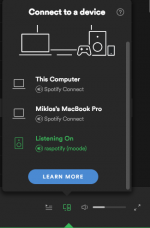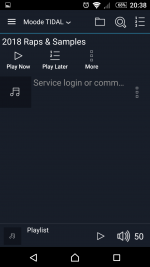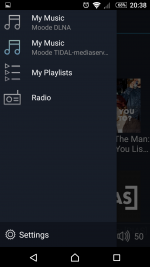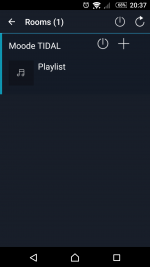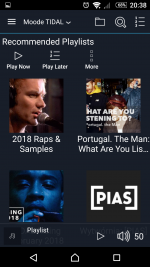Hi. I am using tidal with moode and bubblePnP. But I am controlling the tidal part with an app called LUMIN. It works flawlessly in 4.0 [emoji106]
Where are you choosing the songs and playlists within moode?
Best regards
@Runefrost
Interesting that LUMIN works. I'll have to give it a go to see if, perhaps, the problem is in BubbleUPnP rather than upmpdci (although I'm the one who mentioned BubbleUPnP is my control point; I don't know what @Rucia1 is using).
Since we're talking UPnP here with moOde as the renderer, all track selections are made in the control point. moODe doesn't have the necessary control point functionality.
Regards,
Kent
Hey guys
I tried to install moode last night with Dietpi, but the install failed. For some reason, it complained about the ethernet interface.
Wondering if anybody has installed moode on Dietpi recently?
Installed per this page, diet pi install
Nov 15th, post by Fourdee.
I didn't make any changes to the dietpi.txt file. I could enable wifi, but since ethernet is connected that should work.
Randy
Hi, Randy.
I haven't had time to follow DietPi recently. When I last tried its custom moOde installation there were issues resulting from DietPi's move to Raspian Stretch which included contention between moOde and DietPi over networking (each has its own way of dealing with user configuration). I suspected there would be other areas to be smoothed out too, especially if the intent was to install multiple applications on one host.
Since then, the automated moOde OS Image Builder has progressed to the point that I consider it as easy and reliable to use as the DietPi installer potentially will be.
This is not an attempt to dis DietPi. I think it is a great effort and I hope in the end moOde is as easy to install in it as are the many other software apps it recognizes. I have used it for other purposes and on other SBCs besides RPi.
The trouble is, that "Swiss Army knife" nature of DietPI means its development efforts are spread all over the software and hardware landscape, while the aMOIB development effort is focused on moOde on the RPi.
Regards,
Kent
@Runefrost
Interesting that LUMIN works. I'll have to give it a go to see if, perhaps, the problem is in BubbleUPnP rather than upmpdci (although I'm the one who mentioned BubbleUPnP is my control point; I don't know what @Rucia1 is using).
Since we're talking UPnP here with moOde as the renderer, all track selections are made in the control point. moODe doesn't have the necessary control point functionality.
Regards,
Kent
Would be interesting to see if Linn Kazoo works, in previous conversations with the developer he said that the control points don't always ask for things in the same way.
If I get chance over the weekend I will have a look, but if someone can enable logging level 5 in the upmpdcli.conf file in /etc and uncomment the log filename entry and restart the service or reboot the PI then something maybe visible in here and syslog.
Will have to sort out a trial sub so it will probably be Sunday before I can look.
Hi, Randy.
I haven't had time to follow DietPi recently. When I last tried its custom moOde installation there were issues resulting from DietPi's move to Raspian Stretch which included contention between moOde and DietPi over networking (each has its own way of dealing with user configuration). I suspected there would be other areas to be smoothed out too, especially if the intent was to install multiple applications on one host.
Since then, the automated moOde OS Image Builder has progressed to the point that I consider it as easy and reliable to use as the DietPi installer potentially will be.
This is not an attempt to dis DietPi. I think it is a great effort and I hope in the end moOde is as easy to install in it as are the many other software apps it recognizes. I have used it for other purposes and on other SBCs besides RPi.
The trouble is, that "Swiss Army knife" nature of DietPI means its development efforts are spread all over the software and hardware landscape, while the aMOIB development effort is focused on moOde on the RPi.
Regards,
Kent
Hi Kent
Thanks for the reply. I was hoping someone has had recent success with dietpi, otherwise I'll try installing on a standard stretch lite os with the moode tools.
I managed to successfully complete v 4 build using the Image Builder on one of my Pis but am failing on another. I have redone the process on the card about 3 or 4 times reinstalling stretch lite and it keeps failing at starting the SMB daemons.
Any ideas anybody?
Thanks David
Hi David,
Could you please give us more details ?
Model of pi, Ethernet ? WiFi ? Every specific details about hardware ? ... and post the result of mosbrief AND moslast commands just after failing
Regards
-Eric
How to make Spotify(raspotify) work with Moode 4
Hello,
First of all, thanks for Moode. it's an excellent player with a neat interface. Kudos, Tim!
The only thing that I was missing from Moode was the Spotify support. The airplay and bluetooth both work fine so I could have streamed the music from my tablet or phone, but that just wouldn't felt like the best solution. The good thing (in contrast with other players) is that Moode is based on raspbian and it's relatively easy to fix these things if the solution exists for Linux.
Here is how I installed raspotify, maybe somebody will find it useful.
These steps needs to be executed once you have a fully working Moode 4.
Hello,
First of all, thanks for Moode. it's an excellent player with a neat interface. Kudos, Tim!
The only thing that I was missing from Moode was the Spotify support. The airplay and bluetooth both work fine so I could have streamed the music from my tablet or phone, but that just wouldn't felt like the best solution. The good thing (in contrast with other players) is that Moode is based on raspbian and it's relatively easy to fix these things if the solution exists for Linux.
Here is how I installed raspotify, maybe somebody will find it useful.
These steps needs to be executed once you have a fully working Moode 4.
HTML:
Enable SSH:(on the web interface)
configure/system/SSH term server - switch to ON and press SET
open a terminal:
ssh in to the box with username 'pi' and password 'moodeaudio'
the ip can be found under configure/network on the web UI:
ssh pi@192.168.1.30
execute the following
sudo curl -sL [url]https://dtcooper.github.io/raspotify/install.sh[/url] | sh
#execute these only if you have a Premium account, change INSERT_USERNAME_HERE and INSERT_PASSWORD_HERE only:
sudo sed -E 's/#OPTIONS="--username <USERNAME> --password <PASSWORD>"/OPTIONS="--username INSERT_USERANEME_HERE --password '"'INSERT_PASSWORD_HERE'"' "/ ' /etc/default/raspotify
#set the bitrate to 320
sed -E -i 's/BITRATE="(.+)"/BITRATE="320"/' /etc/default/raspotify
#restart the daemon
systemctl restart raspotify
Disable SSH if you don't need it anymore:
configure/system/SSH term server - switch to OFF and press SETAttachments
I use linnkazoo@Runefrost
Interesting that LUMIN works. I'll have to give it a go to see if, perhaps, the problem is in BubbleUPnP rather than upmpdci (although I'm the one who mentioned BubbleUPnP is my control point; I don't know what @Rucia1 is using).
Since we're talking UPnP here with moOde as the renderer, all track selections are made in the control point. moODe doesn't have the necessary control point functionality.
Regards,
Kent
Attachments
Support for playlists (e.g. Featured Playlists) in Tidal is broken with all upnp control points that I’ve tried, including Lumin. Something must have changed on Tidal’s end.Interesting that LUMIN works. I'll have to give it a go to see if, perhaps, the problem is in BubbleUPnP rather than upmpdci (although I'm the one who mentioned BubbleUPnP is my control point; I don't know what @Rucia1 is using).
Yes, I run with volume control disabled.
I tested by resetting to Hardware and then to Software volume control and you are correct, it is a mute button in both those cases. It makes sense that the buttton would have no effect where volume control is disabled.
(Low priority requests) That being said, and the mystery having been resolved, I would suggest1. there could be pop-up text saying "mute", for consistentcy of the interface (which is remarkably good at informing the user along the way); andThanks!
2. the icon could have the speaker circled and with a slash through it, to better telegraph it's function.
Wibo
3) when volume is set as 'Disabled' the redundant mute button should not appear at all.....
It should be visible for SW/HW volume only...
Tim....swizzle.... should be doable ??
Thanks ~ It's *really* easy to accidentally hit that slider where it is. And the position slider is **really** tiny.
I'm surprised people want the artwork - but then I don't get running it from a large monitor (it's audio...)
If I have my computer on - I can just as easy play or stream from IT to my DAC or whatever....

My thoughts on this are I liked the former style volume control a lot better. I'm OK with the artwork size... I'm in the camp of wanting to see it.
My main issue with the new control, is that it does not update the volume indicator, knob or whatever you call it as you adjust. There's no feedback on what you're changed the volume to till you let go of the slider. Previously, you would see the number changing as you moved it, MUCH easier to set to a particular level, or know what you just did. I don't remember clearly now if the volume itself would slowly slide up as the numbers rose, or it would only make the change after you let go of the knob, but the number feedback is the important part for ease of use, IMO. Before I could easily set to the exact volume number, now I have a hard time not doing worse than plus or minus 5 counts.
I also think that I'm hitting it accidentally more often as well in the new position. Not sure if this isn't a getting used to issue or not, but the new positioning seems to make it easier to accidentally bump, especially on the phone in the portrait orientation as I usually use.
It's a danger, when you're driving a system with a high power amp, and you are using the Moode volume control as the sole level control. I think the knob format has a smaller "danger zone" screen footprint than the horizontal bar, or at least it's more towards the center. Seems all to easy for a scroll down to the playlist accidentally blasting my latest 4" speaker project with a full 100W, or going from quiet listening to blowing my ears out on headphones.
And while we're talking volume features, a nice thing from dear old Winamp was when you stop playing, there was a fadeout. The volume wouldn't just cut, like most other players, it would fade to zero in a short time. Sounds and feels much nicer. There was an adjustment for it too, but the default (250ms, 500ms?) sounded great and took the edge off the sharp cut. It might also be something to explore in volume changes as well, to reduce the sharp jump of a large volume change.
Should be, or disabled if Tim prefers to keep it on screen.3) when volume is set as 'Disabled' the redundant mute button should not appear at all.....
It should be visible for SW/HW volume only...
Ideally (in theory anyway, I have volume disabled so in practice it might not be that great) to me mute would be toggled by tapping the middle of the volume dial but that’s already assigned to editing the number as a text input for ocd people. I’d like to have the control be range limited, currently it's 0-100 and the volume warning limits the portion of the control that is usable. It makes more sense to me that the upper range of the input would be the value set in volume warning so that you could use the full range to set 0-20 (if 20 was the volume warning number) and skip the warning dialog. This would likely mean the page would need to be refreshed if you change the volume limit in the customization dialog but that’s probably not a common enough occurrence for it to be burdensome.
Hello all!
I am still in 3.7... I have missed so much sense.... How can I update to 4.0?
Do I do it on the same pi or I can download it on any linux machine and compile it?
Thanks!
http://www.diyaudio.com/forums/pc-based/271811-moode-audio-player-raspberry-pi-1302.html#post5325432
http://www.diyaudio.com/forums/pc-based/271811-moode-audio-player-raspberry-pi-1397.html#post5352546
Live updating with the html5 range slider is kind of laggy, well, laggier than the knob, so we decided to have it update when you finished dragging. See my other post about range limiting the volume control.My main issue with the new control, is that it does not update the volume indicator, knob or whatever you call it as you adjust. There's no feedback on what you're changed the volume to till you let go of the slider. Previously, you would see the number changing as you moved it, MUCH easier to set to a particular level, or know what you just did. I don't remember clearly now if the volume itself would slowly slide up as the numbers rose, or it would only make the change after you let go of the knob, but the number feedback is the important part for ease of use, IMO. Before I could easily set to the exact volume number, now I have a hard time not doing worse than plus or minus 5 counts.
It originally was shorter and the thumb not as large but was changed to make it easier to grab, maybe too easy? Anyway I think Tim’s (who does use the volume controls) current thought is to change it to a popup dialog with the knob style control which will require a more deliberate action.I also think that I'm hitting it accidentally more often as well in the new position. Not sure if this isn't a getting used to issue or not, but the new positioning seems to make it easier to accidentally bump, especially on the phone in the portrait orientation as I usually use.
It's a danger, when you're driving a system with a high power amp, and you are using the Moode volume control as the sole level control. I think the knob format has a smaller "danger zone" screen footprint than the horizontal bar, or at least it's more towards the center. Seems all to easy for a scroll down to the playlist accidentally blasting my latest 4" speaker project with a full 100W, or going from quiet listening to blowing my ears out on headphones.Man, that really messes with my Moode...
That’d be more on the mpd end of things I think.And while we're talking volume features, a nice thing from dear old Winamp was when you stop playing, there was a fadeout. The volume wouldn't just cut, like most other players, it would fade to zero in a short time. Sounds and feels much nicer. There was an adjustment for it too, but the default (250ms, 500ms?) sounded great and took the edge off the sharp cut. It might also be something to explore in volume changes as well, to reduce the sharp jump of a large volume change.
Should be, or disabled if Tim prefers to keep it on screen.
Ideally (in theory anyway, I have volume disabled so in practice it might not be that great) to me mute would be toggled by tapping the middle of the volume dial but that’s already assigned to editing the number as a text input for ocd people. I’d like to have the control be range limited, currently it's 0-100 and the volume warning limits the portion of the control that is usable. It makes more sense to me that the upper range of the input would be the value set in volume warning so that you could use the full range to set 0-20 (if 20 was the volume warning number) and skip the warning dialog. This would likely mean the page would need to be refreshed if you change the volume limit in the customization dialog but that’s probably not a common enough occurrence for it to be burdensome.
Hi Swizzle,
A couple of comments. Although you can enter a value in the centre of the volume circle, and the volume circle changes to reflect the value it actually has no affect on the volume. At least it doesn't in 4.1c.
Also, the range is only partially limited to 0-100. You can use a mouse wheel or equivalent to attempt to set it to 101. You will get the volume warning message saying volume setting 101 exceeds warning limit of 100.
I don't think refreshing the page after volume customization would be a burden.
Cheers.
Resampling settings magic
Good evening Moode fans,
A question for all you technogeeks / audiophile types (I like to think I'm one of them, but I lack knowledge in this particular area, being new to the designated DAC world...)
Essentially I'm looking to know what's best to "feed" the DAC.
Im running a Pi3B with HiFiBerry DAC+Pro.
I've searched high and wide for info about best practices for optimal sound, with an eye on technical explanations as to why, but there does not seem to be much better than "try out different settings and see if you like them". I understand that listening experience is partly subjective, but there has to be some best practices for the chain from digital sourcefile to analogue DAC-out.
As I understand it, the chain goes somthing like this:
When I request "Audio Info" from the menu, it gives the following info for my DAC:
I've taken to doing a sox resampling to 24/192, to match the Architecture cited above, but I'm not at all sure this makes any technical sense, though it does sound pretty sweet.
I fully understand the idea of resampling, along with the pitfals in the form of potentially introducing artefacts, etc, (sox is technically pretty excellent, see SRC Comparisons), but what I'm struggling to understand is the best practice for my equipment. I'd hate to, for instance, up-sample by software beyond what the DAC can handle, only for the DAC to just down-sample by default and lose some precious fidelity and possibly introduce artefacts that could have been avoided.
I've read much about Sox and Mpd and I spent far too much time at the HiFiBerry forum, but even the maker seems to shy away from taking a firm stance on how to best set up and use his otherwise impressive little product to it's optimal performance.
Please tell me not only what I should do, but mostly why, because for me at least, part of the satisfaction I get from the listening experience is that I've got it right, technically speaking - it's all important, from excellent taste in music (IMVHO) , to good quality ripping, to an excellent little hardware marvel, with a pretty near perfect software package, Moode!
, to good quality ripping, to an excellent little hardware marvel, with a pretty near perfect software package, Moode!
Thanks in advance
Wibo
Good evening Moode fans,
A question for all you technogeeks / audiophile types (I like to think I'm one of them, but I lack knowledge in this particular area, being new to the designated DAC world...)
Essentially I'm looking to know what's best to "feed" the DAC.
Im running a Pi3B with HiFiBerry DAC+Pro.
I've searched high and wide for info about best practices for optimal sound, with an eye on technical explanations as to why, but there does not seem to be much better than "try out different settings and see if you like them". I understand that listening experience is partly subjective, but there has to be some best practices for the chain from digital sourcefile to analogue DAC-out.
As I understand it, the chain goes somthing like this:
- File with native bit depth/sample rate;
- --> mpd+sox where the digital stream gets resampled to new bit/sample rate (I understand this to be accomplished by the computer, independant of the DAC);
- --> the resampled stream is sent to the DAC (or if no software resampling, the original un-resampled stream gets sent);
- --> DAC can (or necessarily does?) resample; and finally
- --> DAC converts to analogue and out to RCA jacks.
When I request "Audio Info" from the menu, it gives the following info for my DAC:
Audio Device
Device: HiFiBerry DAC+ Pro
Chip: Burr Brown PCM5122
Architecture: Sigma/Delta Advanced Segment 24 bit 192 kHz
Interface: I2S
What is this 24/192 Architecture referring to? Is it the prefered input? is it the default for "harware resampling" prior to analogue conversion? Or something else altogether?Device: HiFiBerry DAC+ Pro
Chip: Burr Brown PCM5122
Architecture: Sigma/Delta Advanced Segment 24 bit 192 kHz
Interface: I2S
I've taken to doing a sox resampling to 24/192, to match the Architecture cited above, but I'm not at all sure this makes any technical sense, though it does sound pretty sweet.
I fully understand the idea of resampling, along with the pitfals in the form of potentially introducing artefacts, etc, (sox is technically pretty excellent, see SRC Comparisons), but what I'm struggling to understand is the best practice for my equipment. I'd hate to, for instance, up-sample by software beyond what the DAC can handle, only for the DAC to just down-sample by default and lose some precious fidelity and possibly introduce artefacts that could have been avoided.
I've read much about Sox and Mpd and I spent far too much time at the HiFiBerry forum, but even the maker seems to shy away from taking a firm stance on how to best set up and use his otherwise impressive little product to it's optimal performance.
Please tell me not only what I should do, but mostly why, because for me at least, part of the satisfaction I get from the listening experience is that I've got it right, technically speaking - it's all important, from excellent taste in music (IMVHO)
Thanks in advance
Wibo
I'm sorry for the long post, but I'd like to get to the bottom of a small issue I haven't understood re TIDAL when using upmpdcli in Moode4 vs BubbleUPnP server.
This is my issue: I have setup both upmpdcli in Moode4 and BubbleUPnP server for accessing my Tidal account.
However when I browse UPNP sources with Linn Kazoo pointing to my "Moode UPNP 4" room I first get this error:

And my "Home View" in Linn does NOT show Tidal directly.
Tidal can be accessed only browsing into "My Music"



On the contrary, when I browse UPNP sources with Linn Kazoo pointing to my "BubbleUPnP" room Tidal button is directly available:

The same thing using LuminApp as a controller.
With "Moode UPNP 4" Tidal button IS NOT there (and I cannot browse Tidal at all!):

While with "BubbleUPnP" Tidal button IS there:

Not a big deal, but it would seem to me that OpenHome fetaures implementation in upmdpcli is not complete.... or am I doing something wrong?
Thanks
Franz
This is my issue: I have setup both upmpdcli in Moode4 and BubbleUPnP server for accessing my Tidal account.
However when I browse UPNP sources with Linn Kazoo pointing to my "Moode UPNP 4" room I first get this error:

And my "Home View" in Linn does NOT show Tidal directly.
Tidal can be accessed only browsing into "My Music"



On the contrary, when I browse UPNP sources with Linn Kazoo pointing to my "BubbleUPnP" room Tidal button is directly available:

The same thing using LuminApp as a controller.
With "Moode UPNP 4" Tidal button IS NOT there (and I cannot browse Tidal at all!):
While with "BubbleUPnP" Tidal button IS there:
Not a big deal, but it would seem to me that OpenHome fetaures implementation in upmdpcli is not complete.... or am I doing something wrong?
Thanks
Franz
Hi folks
Really enjoying Moode 4, thanks to Tim and all who contributed.
A potential heads up for Raspostify users...
I added Raspotify along side Moode a while ago which has worked fine until the last few days but I'm experiencing some issues now and am unable to connect via the Spotify iphone and ipad apps, although Raspotify is visible to the app.
I wonder if a recent iOS app update in the last week or so is the cause as my Mac OSX version (my current version is 1.0.64.399) still connects to Raspotify and plays as normal. There is an update available for the OSX app but I'm holding back on that one now.
I've tried restarts all round and updates to Raspotify (non available) but the iOS apps still don't connect. Raspotify is visible and if playing via the Mac I can see what's playing in the iOS apps but any attempt to interect via iOS results in a stall. The only recent changes in my set up I can think of is the Spotify app update.
Are any other Moode and Raspotify user experiencing issues like this? I can't see any issues reported anywhere else so I might well be jumping to conclusions (novice alert!) but it might be worth being cautious about iOS app updates for the moment.
Adrian
Really enjoying Moode 4, thanks to Tim and all who contributed.
A potential heads up for Raspostify users...
I added Raspotify along side Moode a while ago which has worked fine until the last few days but I'm experiencing some issues now and am unable to connect via the Spotify iphone and ipad apps, although Raspotify is visible to the app.
I wonder if a recent iOS app update in the last week or so is the cause as my Mac OSX version (my current version is 1.0.64.399) still connects to Raspotify and plays as normal. There is an update available for the OSX app but I'm holding back on that one now.
I've tried restarts all round and updates to Raspotify (non available) but the iOS apps still don't connect. Raspotify is visible and if playing via the Mac I can see what's playing in the iOS apps but any attempt to interect via iOS results in a stall. The only recent changes in my set up I can think of is the Spotify app update.
Are any other Moode and Raspotify user experiencing issues like this? I can't see any issues reported anywhere else so I might well be jumping to conclusions (novice alert!) but it might be worth being cautious about iOS app updates for the moment.
Adrian
Minidsp and i2s
Hi peeps
anyone got any experience with moode i2s to mindsp ?
Seems to me to make sense to keep it digital all the way and to avoid the USB bus on the pi
just looking for advice to get me started, ie what minidsp product to get for an active 3 way speaker system & is there a minidsp compatible moode i2s option etc ?
lx
Hi peeps
anyone got any experience with moode i2s to mindsp ?
Seems to me to make sense to keep it digital all the way and to avoid the USB bus on the pi
just looking for advice to get me started, ie what minidsp product to get for an active 3 way speaker system & is there a minidsp compatible moode i2s option etc ?
lx
A potential heads up for Raspostify users...
I've tried restarts all round and updates to Raspotify (non available) but the iOS apps still don't connect. Raspotify is visible and if playing via the Mac I can see what's playing in the iOS apps but any attempt to interect via iOS results in a stall. The only recent changes in my set up I can think of is the Spotify app update.
have you tried rerunning the SSH raspotify install command ? it fixed some recent android problems I was having and didn't affect name customisations etc
Lx
- Home
- Source & Line
- PC Based
- Moode Audio Player for Raspberry Pi
